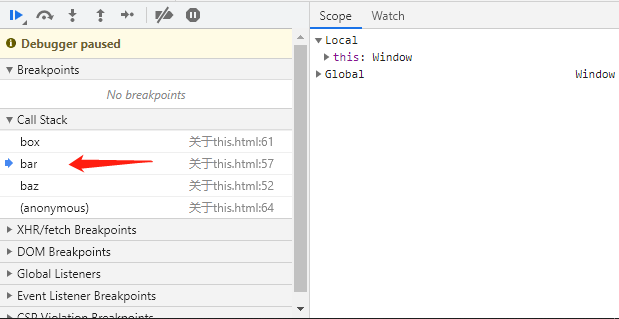关于 this
this 是什么
举个例子:
function foo (num) {
console.log('foo:' + num)
this.count++
}
foo.count = 0
for (var i = 0; i < 10; i++) {
if (i > 5) {
foo(i)
}
}
// foo: 6
// foo: 7
// foo: 8
// foo: 9
console.log(foo.count) // 0
分析:从 foo 函数输出的 4 条记录来看,foo 函数的确被执行了 4 次,但是 foo.count 输出的结果居然是 0。在执行 foo.count = 0 时,已经向函数对象 foo 添加了属性 count,但是函数内部代码 this.count 中的 this 并不指向函数对象,所以 foo.count 才会输出 0。
结论:this 的绑定和函数声明的位置没有任何关系,只取决于函数的调用方式。
扩展:当一个函数被调用时,会创建一个活动记录(执行上下文)。这个记录会包含函数在哪里调用(调用栈)、函数的调用方式、传入的参数信息。this 就是这个记录的一个属性,会在函数执行的过程中用到。
既然 this 的指向和函数的调用位置有关,那么在开发的时候如何判断呢?我们使用日常开发的调试工具 Chrome 浏览器来查看下。
举个例子:
function baz () {
console.log('baz')
bar()
}
function bar () {
console.log('bar')
box()
}
function box () {
debugger; // 断点
console.log('box')
}
baz()
查看浏览器截图如下:


从调用栈列表中我们分析出 box 函数的调用位置是在 bar 这里。 分析调用栈(就是为了到达当前执行位置所调用的所有函数)。真正的调用位置就在当前正在执行的函数的前一个调用中。
this 绑定规则
默认规则
这是最常用的函数调用类型:独立函数调用。可以把这条规则看作是无法应用其他规则时的默认规则。
举个例子:
// demo1
function foo1 () {
console.log(this.name1)
}
var name1 = 'bar'
foo1() // bar
// demo2
function foo2 () {
'use strict'
console.log(this.name2)
}
var name2 = 'bar'
foo2() // TypeError: this is undefined
// demo3
function foo3 () {
console.log(this.name3)
}
var name3 = 'bar'
(function () {
'use strict'
foo3() // bar
})()
分析:在全局作用域声明的变量就是全局对象的一个属性。因此 this.name 的 this 指向全局对象。 如果函数运行在严格模式(demo2),则不能将全局对象用于默认绑定,因此 this 会绑定到 undefined,而在严格模式下调用则不影响 foo3() 函数的默认绑定。换句话说,决定 this 绑定对象的并不是调用位置是否处于严格模式,而是函数体是否处于严格模式,如果函数体处于严格模式,那么 this 就会被绑定到 undefined,否则就被绑定到全局对象。
注意
日常开发的时候,不应该将严格模式和非严格模式混合使用。整个程序要么严格要么非严格。
隐式绑定
这是调用位置是否有上下文对象,或者说是否被某个对象拥有或者包含。
举个例子:
function foo () {
console.log(this.name)
}
var obj = {
name: 'bar',
foo: foo
}
obj.foo() // bar
分析:调用位置会使用 obj 上下文来引用函数,因此你可以说函数被调用时 obj 对象 “拥有” 或 “包含”函数引用。所以这里的 this 会使用隐式绑定到 obj 上下文对象上。
举个例子:
function foo () {
console.log(this.name)
}
var obj1 = {
name: 'bar1',
foo: foo
}
var obj2 = {
name: 'bar2',
obj1: obj1
}
obj2.obj1.foo() // bar1
分析:对象属性引用链中只有上一层或者说最后一层在调用位置中起作用。
举个例子:
function foo () {
console.log(this.name)
}
function doFoo (fn) {
fn()
}
var obj = {
name: 'bar',
foo: foo
}
var name = 'global bar'
doFun(obj.foo) // global bar
分析:fn 参数是 obj.foo 的一个引用,它引用的是 foo 函数本身,再来看 fn() 此时的调用位置是在 doFoo 调用栈里,所以当前调用位置是全局作用域,此时 this 被绑定到全局对象上了。
显式绑定
call() 和 apply() 方法的第一个参数是一个对象,是给 this 准备的,接着在调用函数时将其绑定到 this。因此可以直接指定 this 的绑定对象,我们称为显式绑定。
举个例子:
function foo () {
console.log(this.name)
}
var obj = {
name: 'bar'
}
foo.call(obj) // bar
分析:通过 foo.call(),我们可以在调用 foo 时强制把它的 this 绑定到 obj 上。这里使用 foo.apply() 也可以达到一样的结果,它们的区别是其他参数上。
提示
如果你传入一个原始值(String、Boolean或Number)来当作 this 的绑定对象,这个原始值会被转换成它的对象形式(new String()、new Boolean()或new Number()),这称为基本包装类型的对象。
硬绑定
举个例子:
function foo () {
console.log(this.name)
}
var obj = {
name: 'bar'
}
function baz () {
foo.call(obj)
}
baz() // bar
setTimeout(baz, 100) // bar
baz.call(window) // bar
分析:创建了函数 baz(),并在它的内部手动调用了 foo.call(obj),因此强制把 foo 的 this 绑定到了 obj。不管 baz 函数怎么被调用,foo 的 this 总会绑定到 obj 上。这种绑定是一种显示的强制绑定,因此称为硬绑定。
硬绑定应用场景
一、典型的就是创建一个包裹函数,负责接收参数并返回值:
function foo () {
console.log(this.a, b)
return this.a + b
}
var obj = {
a: 2
}
function bar () {
return foo.apply(obj, arguments)
}
var baz = bar(3)
console.log(baz) // 5
二、创建一个可以重复使用的辅助函数:
function foo (b) {
console.log(this.a, b)
return this.a + b
}
var obj = {
a: 2
}
function bind (fn, obj) {
return function () {
return fn.apply(obj, arguments)
}
}
var bar = bind(foo, obj)
var res = bar(3)
console.log(res) // 5
由于硬绑定是一种非常常用的模式,所以 ES5 内置了 bind 方法。它的用法如下:
function foo (b) {
console.log(this.a, b)
return this.a + b
}
var obj = {
a: 2
}
var bar = foo.bind(obj)
var res = bar(3)
console.log(res) // 5
new 绑定
通过 new 调用的函数,我们称之为构造函数调用。使用 new 来调用函数会自动执行下面的操作:
- 创建(或者说构造)一个全新的对象。
- 这个新对象会被执行
[[Prototype]]连接。 - 这个新对象会绑定到函数调用的 this。
- 如果函数没有返回其他对象,那么 new 表达式中的函数调用会自动返回这个新对象。
举个例子:
function foo (name) {
this.name = name
}
var bar = new foo('huitoutunao')
console.log(bar.name) // huitoutunao
分析:使用 new 来调用 foo() 时,会构造一个新对象并把它绑定到 foo() 调用中的 this 上。
优先级
上面介绍了四条绑定 this 的规则,如果某个调用位置满足这四条规则的条件,该怎么办呢?
不用担心,它们是有使用优先级的,排序为:new 绑定 > 显示绑定 > 隐式绑定 > 默认绑定。
如果将 null 或 undefined 作为 this 的绑定对象传入 call、apply 或 bind,这些值在调用时会被忽略,此时应用的是默认绑定规则。
然而,总是使用 null 来忽略 this 绑定可能会产生一些副作用。例如:第三方库的某个函数上使用了 this,而你使用 null 来忽略 this 绑定,此时就会把它绑定到全局对象上,结果可能是修改全局对象。
为了避免上述问题,推荐创建一个空对象(Object.create(null))来代替 null,举个例子:
function foo (a, b) {
console.log(a, b)
}
var $null = Object.create(null)
foo.apply($null, [1, 2]) // 1, 2
软绑定
实现默认绑定除了全局对象和 undefined 以外的值,以及保留隐式绑定或显示绑定的能力。解决了硬绑定没有的灵活性。
if (!Function.prototype.softBind) {
Function.prototype.softBind = function (obj) {
var fn = this // 这里的 this 和 bound 函数里面的 this 指向不同对象。这里是指调用 softBind() 的对象。
var curried = [].slice.call(arguments, 1) // 因为规定第一个必须传入对象,所以从参数的第二个开始截取。
// 闭包
var bound = function () {
var _this = null
var args = curried.concat.apply(curried, arguments)
// 实现默认绑定除了全局对象和 undefined 以外的值,以及保留隐式绑定或显示绑定的能力。
if (!this || this === (window || global)) {
_this = obj
} else {
_this = this
}
return fn.apply(_this, args)
}
bound.prototype = Object.create(fn.prototype)
return bound
}
}
function foo () {
console.log('name:' + this.name)
}
var obj1 = {
name: '小明'
}
var obj2 = {
name: '小米'
}
var obj3 = {
name: '小红'
}
// 默认绑定
var fooBindJ = foo.softBind(obj1)
fooBindJ() // 小明
// 隐式绑定
obj2.foo = foo.softBind(obj1)
obj2.foo() // 小米
// 显示绑定
fooBindJ.call(obj3) // 小红
this 词法
ES6 新增了一种无法使用上述四种规则的特殊函数:箭头函数(=>)。它是根据外层(函数或者全局)作用域来决定 this。
举个例子:
function foo () {
return (a) => {
console.log(this.a)
}
}
var obj1 = {
a: 2
}
var obj2 = {
a: 3
}
var bar = foo.call(obj1)
bar.call(obj2) // 2
分析:由于 foo() 的 this 被绑定到 obj1 上了,所以 bar(返回的箭头函数)的 this 也会绑定到 obj1 上,而且箭头函数的绑定无法修改,new 也不行!
用途:常用于回调函数中,例如事件或定时器。
结语
在学习 JavaScript 基础中,关于 this 部分比较难以理解,同时也是最重要的内容,所以为了使自己能够对 this 这块知识体系的理解更加深入,写下了这篇文章总结。希望对你们也有所帮助。
以上内容是参考《你不知道的JavaScript》中,关于 this 解析所整理出来的总结。
